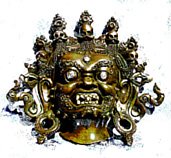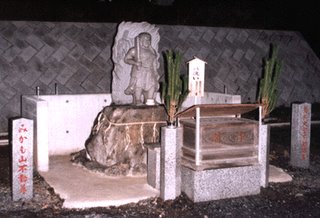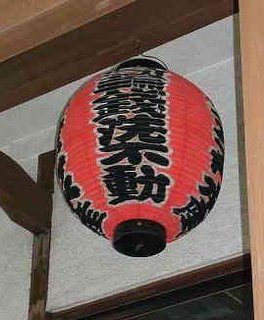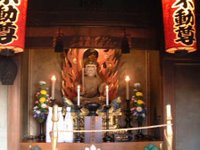[ . BACK to Daruma Museum TOP . ]
:::::::::::::::::::::::::::::::::::::::::::::::::::::::::::::::::::::::::::::::::::::::::::::::::::::::
Fudou Myou-Ou
Shingon - Mantra of Fudo Myo-O 不動明王の真言
Fudō's
"Mantra of Compassionate Help" (Jikushu 慈救呪)
noomaku sanmanda
bazaradan senda
makaroshada
sowataya un tarata kanman

Namah samanta-vajrânâm canda mahârosana
sphotaya hûm trat hâm mâm (Skt.)
nomaku samanda (sammanda) bazaradan senda
maka roshada sowataya un tarata kanman
Homage to the all-pervading Vajras!
O Violent One of great wrath! Destroy! hûm trat hâm mâm http://www.shingon.org/deities/jusanbutsu/fudo.html
[慈救呪(じくのしゅ)]:
ノウマク サマンダバザラダン センダマカロシャダ ソワタヤウン タラタ カン マン
(遍満する金剛部諸尊に礼したてまつる。暴悪なる大忿怒尊よ。砕破したまえ。忿怒したまえ。
害障を破摧したまえ。ハーン・マーン)

"Recollecting bodhicitta, the matrin Should mentally recite the Acala mantra,
And make his Mudrā,And he will destroy all obstacles.
(MAT III.4. Hodge : 154)
- source : visiblemantra.org -
:::::::::::::::::::::::::::::::::::::::::::::::::::::::::::::::::::::::::::::::::::::::::::::::::::::::

Namah samanta vajranam candamaharosana sphotaya hum trat ham mam
Its means:
"Homage to all the Vajras. The Great Wrathful Canda! Destroy! HUM TRAT HAM MAM."
Candamaharosana is one of the uncommon names of Fudo (Acalanatha) in Sanskrit usually used within the post-Shingon developments of Vajrayana in Tibet, Nepal, etc.
There is a whole scripture devoted to him called the
Candamaharosana Tantra,
There is no English translation of the tantra except for a couple of chapters.
What I have read is quite different from the Acala that we know of in Japan.
As with most post-Shingon scripture it is very very cryptic and sexual in nature.
- source : Tom Bennett - facebook
The Candamaharosana Tantra - TEXT
By Christopher Starr George
- source : ja.scribd.com/doc
:::::::::::::::::::::::::::::::::::::::::::::::::::::::::::::::::::::::::::::::::::::::::::::::::::::::
kaan カーン seed syllable
. Amulets with KAAN 梵字ペンダント(不動のカーン) .

Woodblock print, diptych. Buddhist temple print,
Fudo Myo-o standing with sword and rope, body formed from the seed characters (Siddham script) of his mantra.
Sumizuri-e on paper.
source : www.britishmuseum.org/research
:::::::::::::::::::::::::::::::::::::::::::::::::::::::::::::::::::::::::::::::::::::::::::::::::::::::
Two more mantras of Fudo Myo-0
[火界呪(かかいじゅ)]:
Mantra for the Fire World
noomaku sarabatatagyatebyaku sarababokkeibyaku sarabatatarata
sendamakoroshada ken gyakigyaki sarababykisonasowan tarata kanman
ノウマク サラバタタギャテイビャク サラバボッケイビャク サラバタタラタ
センダマカロシャダ ケン ギャキギャキ サラバビキンナンウン タラタ カンマン
(全方位の一切如来に礼したてまつる。一切時一切処に残害破障したまえ。
悪大忿怒尊よ。カン。一切障難を滅尽に滅尽したまえ。フーン。
残害破障したまえ。 ハーン。マーン。)
[不動一字呪(いちじしゅ)]:
One Word Mantra
Noomaku samanda basaradan kan
ノウマク サマンダ バザラダン カン
(あまねき金剛尊に礼したてまつる。ハーン)
 Kanman
Kanman
:::::::::::::::::::::::::::::::::::::::::::::::::::::::::::::::::::::::::::::::::::::::::::::::::::::
The Marathon Monks of Mount Hiei
..... During the route, Kakudo will sit down only once -- beneath a giant sacred cedar for two minutes -- to pray for the protection of the imperial family. After a first run with a master, Kakudo will be on his own. He may suffer cuts, sprains, stone bruises and punctures to his feet and ankles. He may run a fever, experience back and hip pain, develop hemorrhoids and diarrhea, suffer from frostbite, dehydration and hunger.
But by about the 30th day, according to predecessors' accounts, his discomfort will lessen as his body adapts to the pain and strain. By the 70th day he is run/walking with a smooth gait, head and shoulders erect, back straight, nose and navel aligned.
He will continually chant mantras to the god,
Fudo Myo-o.
His spiritual goal is to become completely absorbed in the mountain and its surroundings, so that the pain and discomfort of the physical ritual will not be noticed, or at least be ignored. Kakudo hopes to achieve a state of Enlightenment-- the pure spiritual joy of feeling one with the universe.
As rugged as it appears, however, this test is merely a warmup in the ultimate spiritual quest of the Marathon Monks -- the complete process entails seven more years and becomes progressively and unfathomably more difficult.
Read the full story here
©
By Dave Ganci
:::::::::::::::::::::::::::::::::::::::::::::::::::::::::::::::::::::::::::::::::::::::::::::::::::::
Mantras, Mudras and Mandalas:
........ Symbolism in Himalayan Art
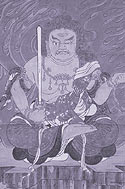
The Buddhist art of the Himalayas is essentially symbolic in nature and is rich with esoteric elements. To unlock its mysteries the viewer must use semiotic codes. Since the Himalayan pieces featured in the exhibition are primarily employed in the service of Buddhism, they are religious in nature. Hence, they were produced in large part either by monks who practiced it, or by the artists [who were knowledgeable in Buddhist iconography].
The practitioners, of course, understood the meaning and symbolism but the laypeople did not. Deepak Shimkhada, assistant professor of art and religion at Claremont, McKenna College is an expert in the subject of Himalayan art and will unveil the mysteries of the mudras and mandalas as seen in the Buddhist art of the Himalayas.
© 2002, the Pacific Asia Museum.
Lecture by Deepak Shimkhada, 2002
http://www.pacificasiamuseum.org/calendar/exhibitions/buddhism.htm
:::::::::::::::::::::::::::::::::::::::::::::::::::::::::::::::::::::::::::::::::::::::::::::::::::::
Fudo Myoo-Oo and Energy Thearpy
Fudo Myo-o - 'the Immovable One' is also patron of the Martial Arts, and patron of all practitioners of mountain-centred ascetic mystic disciplines
There are also
Mantras for the 13 Deities 十三佛の真言

真言十三佛
. . . CLICK here for Photos !
:::::::::::::::::::::::::::::::::::::::::::::::::::::::::::::::::::::::::::::::::::::::::::::::::::
Mantra, Dharani, Waka and Japanese Poetry
Reading the Miraculous Powers of Japanese Poetry
http://www.nanzan-u.ac.jp/SHUBUNKEN/publications/jjrs/pdf/705.pdf
some quotes
...
waka (Japanese poems) achieve their supernatural effects because they are the dharani (magical Buddhist incantations) of Japan —
By the twelfth century,under the in fluence of the Tendai concept of non-duality,many priests, poets and commentators had begun to equate the
Way of Poetry with the
Way of Buddhism.
... the poet-priest Kamo no Chōmei explains that unlike prose, a poem “possesses the power to move heaven and earth, to calm demons and gods,”because, among other attributes,“it contains many truths in a single word ” (hito kotoba ni ōku no kotowari wo kome)
"The exoteric is to consume many words to denote one meaning. The esoteric is to unleash countless meanings from within each letter of a word. This is the secret function of dharani.”
Kukai
Japanese poetry,with its use of puns,pivot-words,pillow-phrases,and various associative and allusive techniques,is characterized by a similar semantic economy. Kamo no Chōmei seems to have thus equated the origins of waka ’s miraculous powers with those of dharani as formulated by Kūkai in the early ninth century.
waka are effective because, as dharani, they express a “natural truth ”that transcends human language. In that they necessarily express that truth in “thirty-one syllables ”— the standard waka format — their power results from both their content and their form.
"Waka are the dharani of Japan.
Waka are the source of magical powers; they are seeds drawing us to enlightenment."
Sonshun 尊舜 (1452 - 1514)
. . . . .
At the time of his founding of the Temple on Mount Hiei, the Master Saicho sought out timber to construct the [statue of ] Yakushi in the Central Hall. In the north-east, he came upon a camphor tree emitting light from its trunk.Thinking this strange, he approached to have a look. Two demons were standing guard, the monk intoned
anokutara
sanmyaku sanbodai no
hotoketachi
waga tatsu soma ni
myooga arasetamae
You Buddhas
of Most Perfect
Enlightened Wisdom ...
bestow your silent protection
on this forest that I fell!
.....
Indian "Truth Acts" and Japanese Power Poetry
(saccakiriyā /satyakriyā )
The Truth Act, like the dharani,was a potent instrument in the magico-religious technology of Indian Buddhism, and it seems to have been adopted — albeit in somewhat condensed form — for use in a number of the miraculous poems of Japan.
.....
- - - - - Moto'ori Norinaga writes:
Question:
In the composition of poetry,if one should put aside truth (makoto 実) and concentrate solely on the crafting of ornate language,is it not the case that however fine a poem one might produce, that poem will fail to stir emotion in demons and gods?
Answer:
To move heaven and earth and stir emotion in demons and gods requires both deep feeling and good poetry.However deep one ’s feelings might be, if one should write,“How sad,how sad,” demons and gods are not likely to be moved. But if a poem is born of an earnest heart and is but skillfully wrought, supernatural beings are sure to be moved of their owna ccord. Likewise, however elegant the language of a poem, should that poem lack feeling, demons and gods are unlikely to respond.
But when people hear a poem that is both profound in sentiment and gracefully crafted,their hearts are naturally touched. So too heaven and earth are moved and demons and gods are affected.
. Kamo no Choomei 鴨長明 Kamo no Chomei .
( 1153 or 1155–1216) Kamo no Chōmei
:::::::::::::::::::::::::::::::::::::::::::::::::::::::::::::::::::::::::::::::::::::::::::::::::::::::::::::::::::::::::::

the
shuji (Skt. bija) or seed syllable 'kan' or 'ham' in Sanskrit. The next is the sanmaya-gyo of Aizen Myoo - it is called a kongoko (Skt. ankusa) or elephant goad. Above it is the shuji of Aizen 'un un' (Skt. hhum). Finally we have the familiar shuji 'A' used in the Ajikan practice.
hāṃ, ham
hammaṃ hammam
hum
- shared by Tom - facebook
:::::::::::::::::::::::::::::::::::::::::::::::::::::::::::::::::::::::::::::::::::::::::::::::::::::::::::::::::::::::::::
There are also many samples of
KAAN in the pendant and amulet entries.
. The Mantra of Shingon Deities .
[ . BACK to DARUMA MUSEUM TOP . ]
[ . BACK to WORLDKIGO . TOP . ]
:::::::::::::::::::::::::::::::::::::::::::::::::::::::::::::::::::::::::::::::::::::::::::::::::::::::::::::::::::::::::::

